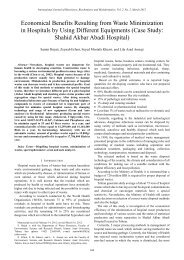Potential Nutritional and Medicinal Sources from Fruit Peels in - ijbbb
Potential Nutritional and Medicinal Sources from Fruit Peels in - ijbbb
Potential Nutritional and Medicinal Sources from Fruit Peels in - ijbbb
Create successful ePaper yourself
Turn your PDF publications into a flip-book with our unique Google optimized e-Paper software.
International Journal of Bioscience, Biochemistry <strong>and</strong> Bio<strong>in</strong>formatics, Vol. 2, No. 4, July 2012<br />
With the st<strong>and</strong>ard curve for atrop<strong>in</strong>e hav<strong>in</strong>g a slope b equal<br />
to 1.25179, <strong>and</strong> a y <strong>in</strong>tercept (a) equal to 0.05817 <strong>and</strong> r<br />
equivalent to 0.9728, the amount of alkaloids <strong>in</strong> lanzones was<br />
determ<strong>in</strong>ed. A 0.0312 mg/ml alkaloid content was measured<br />
<strong>from</strong> lanzones. As the dilution factor used was 10, <strong>from</strong><br />
20g/20ml source of the fruit peel, 0.312 mg/ml alkaloid was<br />
obta<strong>in</strong>ed. <strong>Potential</strong> medic<strong>in</strong>al products may be obta<strong>in</strong>ed <strong>from</strong><br />
fruit peels s<strong>in</strong>ce it conta<strong>in</strong> alkaloids even as it was diluted<br />
<strong>from</strong> the primary source with hydrochloric acid. <strong>Fruit</strong> peels<br />
accumulate daily <strong>in</strong> kilograms <strong>and</strong> <strong>in</strong> tons every month.<br />
F<strong>in</strong>d<strong>in</strong>g alternative uses for it <strong>in</strong> relation to nutrition <strong>and</strong><br />
medic<strong>in</strong>e is best.<br />
Although the qualitative tests showed greatest <strong>in</strong>tensity for<br />
total sugars for all seven samples <strong>and</strong> alkaloids <strong>in</strong> lanzones,<br />
glycosides <strong>and</strong> tann<strong>in</strong>s were also observed <strong>in</strong> all fruit peel<br />
samples analyzed. Glycosides are compounds that yield one<br />
or more sugars as products of hydrolysis. Glycosides<br />
contribute to almost every therapeutic class <strong>in</strong> medic<strong>in</strong>e.<br />
Some of the most valuable cardiac specifics are glycosides<br />
<strong>from</strong> digitalis, strophanthus, squill, convallaria, <strong>and</strong><br />
apocynum among others.Laxative drugs like senna, aloe,<br />
rhubarb, cascara sagrada <strong>and</strong> frangula conta<strong>in</strong> emod<strong>in</strong> <strong>and</strong><br />
other anthraqu<strong>in</strong>one glycosides. From black mustard, s<strong>in</strong>igr<strong>in</strong><br />
yields allyl isothoicyanate, a powerful local irritant.<br />
Gaulther<strong>in</strong> <strong>from</strong> w<strong>in</strong>tergreen yields methyl salicylate which<br />
TABLE III: CONCENTRATION OF TOTAL SUGARS IN SELECTED FRUIT PEELS.<br />
Concentration of total sugars (ug/mL)<br />
is an analgesic. Tann<strong>in</strong>s usually occur as mixtures of<br />
polyphenols. Tann<strong>in</strong>s precipitate prote<strong>in</strong>s<strong>from</strong> solution <strong>and</strong><br />
can comb<strong>in</strong>e with prote<strong>in</strong>s render<strong>in</strong>g them resistant to<br />
proteolytic enzymes. Tann<strong>in</strong>s then are used as astr<strong>in</strong>gents on<br />
gastro<strong>in</strong>test<strong>in</strong>al tract <strong>and</strong> sk<strong>in</strong> abrasions.It is also used <strong>in</strong> the<br />
process of vegetable tann<strong>in</strong>g which converts animal hide to<br />
leather. Tann<strong>in</strong>s are also used as antidote for alkaloidal<br />
poison<strong>in</strong>g. It <strong>in</strong>activates the alkaloid by form<strong>in</strong>g tannates [3].<br />
Varied fruit peels <strong>from</strong> Manila, Philipp<strong>in</strong>es conta<strong>in</strong> heavy<br />
metals like cadmium <strong>and</strong> chromium, which <strong>in</strong>cludes the<br />
samples analyzed <strong>in</strong> this research (Table IV) [13]. Though<br />
the amounts of the heavy metals identified did not go beyond<br />
the allowed limit for pharmaceutical preparations at 10ppm,<br />
it is still best to decontam<strong>in</strong>ate the fruit peels prior to<br />
formulation of nutritional supplements or medic<strong>in</strong>al products.<br />
Tahong (Perna viridis) has the ability to remove heavy<br />
metals, lead <strong>and</strong> cadmium, <strong>from</strong> water sources [14]. As such<br />
it can remove the contam<strong>in</strong>ants <strong>in</strong> the fruit peel decoction<br />
studied. It is also best to isolate <strong>and</strong> purify the active<br />
phytochemicals <strong>from</strong> rambutan (Nepheleum lappacium),<br />
lanzones (Lansium domesticum), pomelo (Citrus gr<strong>and</strong>is),<br />
longgan (Dimocarpus longana), dal<strong>and</strong>an (Citrus nobilis),<br />
ponkan (Citrus reticulata), mangosteen (Garc<strong>in</strong>ia<br />
mangostana) to avoid unwanted chemical contam<strong>in</strong>ants <strong>and</strong><br />
at the same time improve the potency of the preparations.<br />
Mangosteen Ponkan Dal<strong>and</strong>an Lanzones Pomelo Longgan Rambutan<br />
Stock<br />
solution*<br />
>164 >164 >164 >164 >164 >164 >164<br />
1:1 >164 >164 >164 145.1 >164 >164 >164<br />
1:4 >164 >164 >164 110.05 >164 >164 >164<br />
1:9 139.25 >164 >164 39.4 >164 >164 93.65<br />
1:99 8.4 26.95 2.45 1.801 22.5 37.75 12.75<br />
TABLE IV: CADMIUM AND CHROMIUM FROM SELECTED FRUIT PEELS IN MANILA, PHILIPPINES.<br />
Cadmium Chromium<br />
<strong>Fruit</strong>s <strong>Peels</strong> Flesh <strong>Peels</strong> Flesh<br />
longgan 0.001+/-0.0021 0.0101+/-0.0014 0.0001+/-0.0012 0.0002+/-0.0012<br />
lanzones 0.002+/-0.0014 0.0098+/-0.0006 0.0001+/-0.0012 0.0002+/-0.0005<br />
mangosteen 0.0026+/-0.0023 0.003+/-0.0005 0.0011+/-0.0003 0.0013+/-0.0006<br />
rambutan 0.0054+/-0.0007 0.0067+/-0.0006 0.0002+/-0.0005 0.0011+/-0.0008<br />
ponkan 0.0041+/-0.0004 0.005+/-0.0009 0.1143+/-0.0011 0.3613+/-0.0006<br />
dal<strong>and</strong>an 0.0023+/-0.0003 0.0032+/-0.0006 0.1284+/-0.0005 0.206+/-0.0008<br />
Heavy metals like cadmium <strong>and</strong> chromium may result to<br />
unwanted effects to the human body. Cadmium may cause<br />
severe arthralgia <strong>and</strong> osteomalacia <strong>in</strong> middle aged<br />
postmenopausal women with low calcium <strong>and</strong> vitam<strong>in</strong> D<br />
<strong>in</strong>take, or itai-itai disease. It attacks the kidneys on chronic<br />
poison<strong>in</strong>g, lungs <strong>and</strong> gastro<strong>in</strong>test<strong>in</strong>al tract on acute <strong>in</strong>halation<br />
<strong>and</strong> <strong>in</strong>gestion, respectively around 25%is absorbed by<br />
<strong>in</strong>halation, <strong>and</strong> 5% through <strong>in</strong>gestion. It is not well absorbed<br />
through the sk<strong>in</strong> at 0.5% [13].<br />
The toxic potential of chromium depends on its oxidation<br />
state. Chromium (VI) is more toxic than chromium (III).<br />
Ingestion of high amounts of chromium (VI) causes adverse<br />
gastro<strong>in</strong>test<strong>in</strong>al effects <strong>in</strong> humans <strong>and</strong> animals. It causes<br />
unwanted affects to the respiratory, hepatic, endocr<strong>in</strong>e,<br />
immunological, <strong>and</strong> neurologic system. Accumulation of<br />
273<br />
chromium can lead to cancer. It can adversely affect the<br />
gastro<strong>in</strong>test<strong>in</strong>al tract upon <strong>in</strong>gestion [13].<br />
It is because of the reasons stated that heavy metals must<br />
be removed <strong>from</strong> the sample peel wastes before prepar<strong>in</strong>g<br />
nutritional supplements <strong>and</strong> medic<strong>in</strong>al products <strong>from</strong> it. As<br />
this study <strong>in</strong>tended to provide better health conditions to the<br />
Filip<strong>in</strong>o people, it was not just by offer<strong>in</strong>g novel potential<br />
formulations that was considered but also decontam<strong>in</strong>ation of<br />
or isolation <strong>and</strong> purification of the active <strong>in</strong>gredient/s <strong>from</strong><br />
the fruit peel sources.<br />
IV. CONCLUSIONS<br />
All fruit peels qualitatively showed the presence of<br />
reduc<strong>in</strong>g sugars as well as glycosides. Pomelo, rambutan,



